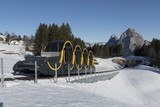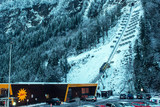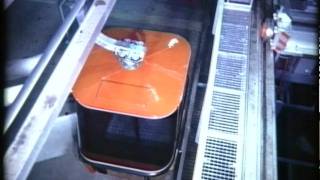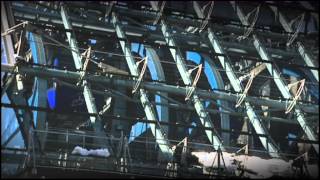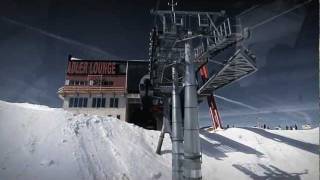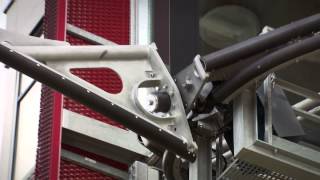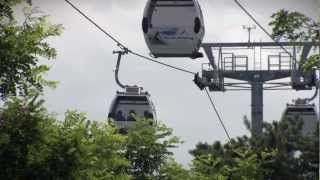On December 17, 2017 at 12:17 p.m. local time, the new Stoos lift was opened for public operation. The new funicular ropeway to the Stoos is not only a generation construction but also an achievement of state-of-the-art ropeway engineering. The changing gradients can be compensated thanks to the four cylindrical passenger sections that are used for the first time ever. The passenger level remains horizontal even during the conquest of the maximum slope of 110%.
Glancing down just before entering the first of the three tunnels of the line reveals a breathtaking view. Only several meters after leaving the bottom station at the Schlattli in Muotathal, there is a steep climb and the carriers reach the maximum slope of 110% shortly. If today there is talk of the world's steepest funicular ropeway or even a miracle of technology – neither the customer nor the ropeway engineers were aiming for any of these descriptors. Paramount were the technical availability of the installation and the associated reduction of possible operational interruptions caused by natural phenomena. The resulting layout of the line between the bottom station in the Schlattli and the top station on the Stoos challenged the engineers to find completely new solutions. The four cylindrical passenger sections that are equipped with gradient compensation have never before been built in this form. While the carriers follow the track, each section gyrates to adapt to the slope – this innovative carrier concept allows for elegantly compensation of this extreme slope. The passenger level remains horizontal at all times and ensures a comfortable ride.
Carrier concept for passengers and goods
Passengers in the funicular ropeway to the Stoos benefit from a generous passenger cabin and an unobstructed view thanks to the large window surface. The company CWA Constructions SA in Olten, Switzerland, constructed the passenger compartments. Each carrier offers space for 136 passengers; in combination with a maximum operating speed of 10 m/s this results in a transport capacity of 1,500 passengers per hour and direction. The passengers can board and leave the carries in the bottom as well as in the top station at ground level, i.e. barrier-free. Goods can be transported at the same time as passengers thanks to a platform provided for this purpose and fitted on the side facing the top station. This platform automatically compensates the slope in the same way as the passenger compartments. The passenger and freight sections were separated logistically to allow for optimal guidance of the passenger flow.
Proven technology
Apart from the innovative carrier concept that is introduced for the first time worldwide, the new Stoos lift uses well-proven technology. The drive unit was transported to the top station in 2015. This called for exceptional precision on the narrow mountain road to safely transport the individual drive elements that weigh up to 16.5 t, such as for example the double-groove drive bullwheel, to their destination. The crossing point of the two carriers located at half the distance of the track was executed with an Abt Switch. This system, developed at the end of the century before last by Carl Roman Abt who was then living in Central Switzerland, consists of a double wheel flange on the outer wheels and a flat roll on the inner wheels, has prevailed and is standard for funiculars today.
Benefit of a funicular ropeway
Two carriers operate on the line and are fixed to a steel rope that is guided around the drive bullwheel in the top station. Thanks to the low-level guidance, a funicular ropeway excels with a high technical availability even in unfavorable weather conditions. Due to the flat sections located before the top and bottom stations, the Stoos lift is equipped with a ballast rope that is anchored in the bottom station with a tensioning weight. This ensures the required design tension of the rope which allows the carrier to enter the bottom station in horizontal position.
| Customer: | Standseilbahn Schwyz-Stoos AG |
| Length: | 1,738 m |
| Of those: | 261 m on a bridge |
| 560 m inside tunnels | |
| Vertical rise: | 743 m |
| Minimum slope: | 0% |
| Maximum slope: | 110% |
| Max. operating speed: | 10 m/s |
| Capacity: | 1,500 passengers per hour and direction |
| Carrier capacity: | 136 passengers |
| Number of carriers: | 2 |
| Haul rope diameter: | 54 / 30 mm |
| Gauge: | 1,500 mm |
| Rated output: | 2x 1,546 hp / 2x 1,150 kW |
| Drive: | located in the top station |
| Manufacturer of carriers: | CWA Constructions SA Olten |
| Supplier of controls: | Sisag AG Schattdorf |
| Supplier of rope: | Fatzer AG Romanshorn |

